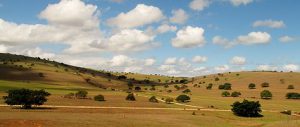We turned off the main road to Awassa, talked our way past security guards and drove nearly two kilometres across empty land before we found what will soon be Ethiopia’s largest greenhouse. Nestling below an escarpment of the Rift Valley, the development is far from finished, but the plastic and steel structure already stretches over 20 hectares – the size of 20 football pitches.
The farm manager shows us millions of tomatoes, peppers and other vegetables being grown in 500-metre rows in computer-controlled conditions. Spanish engineers are building the steel structure, Dutch technology minimises water use from two bore-holes and 1,000 women pick and pack 50 tonnes of food a day. Within 24 hours, it has been driven 320 kilometres to Addis Ababa and flown 1,600 kilometres to the shops and restaurants of Dubai, Jeddah and elsewhere in the Middle East.
Ethiopia is one of the hungriest countries in the world, with more than 13 million people needing food aid, but paradoxically the government is offering at least three million hectares of its most fertile land to rich countries and some of the world’s most wealthy individuals to export food for their own populations.
The 1,000 hectares of land that contain the Awassa greenhouses are leased for 99 years to a Saudi billionaire businessman, Ethiopian-born Sheikh Mohammed al-Amoudi, one of the 50 richest men in the world. His Saudi Star company plans to spend up to US$2 billion acquiring and developing 500,000 hectares of land in Ethiopia in the next few years. So far, it has bought four farms and is already growing wheat, rice, vegetables and flowers for the Saudi market. It expects eventually to employ more than 10,000 people.
But Ethiopia is only one of 20 or more African countries where land is being bought or leased for intensive agriculture on an immense scale in what may be the greatest change of ownership since the colonial era.
An Observer investigation estimates that up to 50 million hectares of land – an area more than double the size of the United Kingdom – has been acquired in the last few years or is in the process of being negotiated by governments and wealthy investors working with state subsidies. The data used was collected by Grain, the International Institute for Environment and Development (IIED), the International Land Coalition (ILC), ActionAid and other non-governmental groups.
The land rush, which is still accelerating, has been triggered by the worldwide food shortages that followed the sharp oil-price rises in 2008, growing water shortages and the European Union’s insistence that 10% of all transport fuel must come from plant-based biofuels by 2015.
In many areas the deals have led to evictions, civil unrest and complaints of “land grabbing”.
The experience of Nyikaw Ochalla, an indigenous Anuak from the Gambella region of Ethiopia now living in Britain but who is in regular contact with farmers in his region, is typical. He said: “All of the land in the Gambella region is utilised. Each community has and looks after its own territory and the rivers and farmlands within it. It is a myth propagated by the government and investors to say that there is waste land or land that is not utilised in Gambella.
“The foreign companies are arriving in large numbers, depriving people of land they have used for centuries. There is no consultation with the indigenous population. The deals are done secretly. The only thing the local people see is people coming with lots of tractors to invade their lands.
“All the land round my family village of Illia has been taken over and is being cleared. People now have to work for an Indian company. Their land has been compulsorily taken and they have been given no compensation. People cannot believe what is happening. Thousands of people will be affected and people will go hungry.”
It is not known if the acquisitions will improve or worsen food security in Africa, or if they will stimulate separatist conflicts, but a major new World Bank report is expected to warn of both the potential benefits and the immense dangers they represent to people and nature.
Leading the rush are international agribusinesses, investment banks, hedge funds, commodity traders, sovereign wealth funds as well as UK pension funds, foundations and individuals attracted by some of the world’s cheapest land.
Together they are scouring Sudan, Kenya, Nigeria, Tanzania, Malawi, Ethiopia, Congo, Zambia, Uganda, Madagascar, Zimbabwe, Mali, Sierra Leone, Ghana and elsewhere. Ethiopia alone has approved 815 foreign-financed agricultural projects since 2007. Any land there, which investors have not been able to buy, is being leased for approximately US$1 per year per hectare.
Saudi Arabia, along with Middle Eastern emirate states such as Qatar, Kuwait and Abu Dhabi, is thought to be the biggest buyer. In 2008 the Saudi government, which was one of the Middle East’s largest wheat-growers, announced it was to reduce its domestic cereal production by 12% a year to conserve its water. It earmarked US$5 billion to provide loans at preferential rates to Saudi companies that wanted to invest in countries with strong agricultural potential.
Meanwhile, the Saudi investment company Foras, backed by the Islamic Development Bank (IsDB) and wealthy Saudi investors, plans to spend US$1 billion buying land and growing seven million tonnes of rice for the Saudi market within seven years. The company says it is investigating buying land in Mali, Senegal, Sudan and Uganda. By turning to Africa to grow its staple crops, Saudi Arabia is not just acquiring Africa’s land but is securing itself the equivalent of hundreds of millions of litres of scarce water a year. Water, says the United Nations, will be the defining resource of the next 100 years.
Since 2008 Saudi investors have bought heavily in Sudan, Egypt, Ethiopia and Kenya. Last year the first sacks of wheat grown in Ethiopia for the Saudi market were presented by al-Amoudi to King Abdullah.
Some of the African deals lined up are eye-wateringly – enormously — large: China has signed a contract with the Democratic Republic of Congo to grow 2.8 million hectares of palm oil for biofuels. Before it fell apart after riots, a proposed 1.2-million-hectare deal between Madagascar and the South Korean company Daewoo would have included nearly half of the country’s arable land.
Land to grow biofuel crops is also in demand. “European biofuel companies have acquired or requested about 3.9 million hectares in Africa. This has led to displacement of people, lack of consultation and compensation, broken promises about wages and job opportunities,” said Tim Rice, author of an ActionAid report that estimates that the European Union needs to grow crops on 17.5 million hectares, well over half the size of Italy, if it is to meet its 10% biofuel target by 2015.
“The biofuel land grab in Africa is already displacing farmers and food production. The number of people going hungry will increase,” he said. British firms have secured tracts of land in Angola, Ethiopia, Mozambique, Nigeria and Tanzania to grow flowers and vegetables.
Indian companies, backed by government loans, have bought or leased hundreds of thousands of hectares in Ethiopia, Kenya, Madagascar, Senegal and Mozambique, where they are growing rice, sugar cane, maize and lentils to feed their domestic market.
NEXT: “Nowhere is out of bounds”
Copyright Guardian News & Media Limited 2010
Homepage image from Catholic Relief Services



